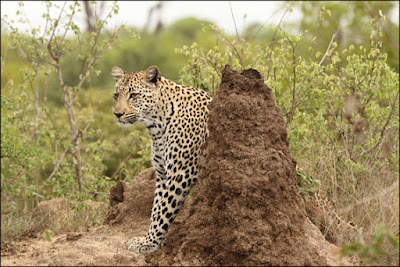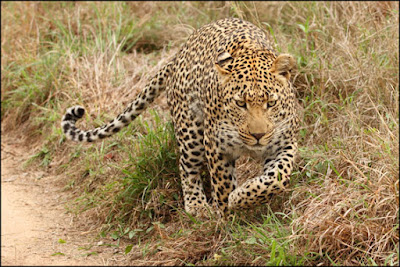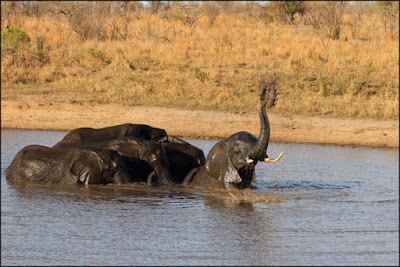The last week sightings have been very good. The Ximungwe
prides have been seen north of the Sand River. The pride killed a blue wildebeest
on the Northern Firebreak; the females were joined by four cubs. The pride has
been spending the good part of the week in this area north of the river.
The cubs were in a playful mood, they tried to stalk each
other with full bellies. After sometime the gravitational effect on the bellies
of the young lions got the better of them.
The Mapogo brothers have been covering a lot of ground. One
of the males has been mating with a female from the Ottawa Pride. The Ottawa
pride has suffered some recent setbacks and the birth of future cubs will start
a new era for the young pride. One an occasion we were very fortunate to have one
of the males vocalising close to the vehicle.
As ever the leopard sightings have been fantastic. Tlangisa
has been seen regularly in the central parts of the western section. As ever we
found her perched in a Marula tree, it seems she enjoys the attention.
Hlabankunzi has been covering large distances stretching
from the Sand River to Mackenzie Cutline. This is possibly due to pressure from
other females. We think she may also be pregnant and is looking for a suitable
area for her cubs.
The Kashane male killed a female impala in the Tulamanzi
drainage system. A large Jackalberry tree sheltered the leopard from the
elements as well as a place of refuge from other predators. He was regularly
seen elevated and resting on the large bows.
We found Shangwa walking in an easterly direction towards
the Sand River. As she approached the dry section of the river the female
started to call for her cub. A male cub appeared from a thicket. The two
leopards moved towards the river bed. We had a fantastic sighting as the two
rested on a large boulder before disappearing into the dense vegetation.
The Day One Male has been seen regularly on the western
firebreak. He was mating with Metsi at Wallingford Dam. The following day the
two had split and gone their separate ways.
A group of bull elephants were encountered swimming in Dam
Five. They are quite boisterous and acted like naughty teenagers in a swimming
pool. A hippo bull kept his distance while the pachyderms enjoyed the cool
water.
We were treated to a very special sighting. While viewing a
herd of elephants an extremely young calf stumbled out of a bush followed by
its mother. Both were extremely relaxed, the calf was very wobbly and uneasy on
his feet. We were under the impression that the small calf was a matter of days
old and still learning how to master its legs.
The breeding herds of buffalo are still present in the
south. The group of old males has settled in the area around the camp. The size
of the group varies as some bulls move off with the breeding herds and are
replaced with bulls that remain behind.
The Burchells Zebra are returning to the southern area once
again, as the new vegetation flourishes the grazing species are seen on the
large clearings. Wildebeest, warthogs and impala are also encountered.
The impala have started dropping their lambs. These
beautiful antelope are often overlooked but are very popular at this time of
the year.
The week has also produced some sightings of some of the
smaller mammals. Dwarf mongooses are very inquisitive creatures, as one
approaches they scatter for cover. After a few brief moments they emerge from
their hiding spots intrigued by the onlookers. One individual approached the
vehicle as the element of danger disappeared.
A lesser bush baby was bouncing across the road on Little Serengeti. This small nocturnal primate has incredible
jumping abilities and rarely stays still long enough to photograph it.
We were treated to a fantastic sighting of a pangolin. These
strange and armoured nocturnal mammals are rarely seen. This particular one was
very relaxed as it scurries about in search of termites, which is its principle
diet.
A hippo bull gave us a great display at Cheetah Flats Pan;
he launched himself out of the water in a show of intimidation to protect his
primary asset, the waterhole.
A sectary bird was seen along Main Mac. This strange but
beautiful bird is an excellent hunter, as it strolls through the bush in search
of snakes and lizards.
A green pigeon keeping her chick warm on a cold day, an
immature Bateleur taking off from a branch and a Water Thick-knee bird was seen
this week. The Water Thick-knee chick didn’t move an inch while its mother was
away from the nest. Any movement may have drawn unwanted attention from some
predatory animal. The Weavers have started building their nests for the
breeding season, each species can be identified by the type of nest that has
been built.
Finally, on the way back to camp one evening we encountered
a female spotted hyena, carrying the remains of a Nyala carcass. We suspect,
that she was returning to a den to feed her offspring. We noticed that the
female was lactating.
























































































